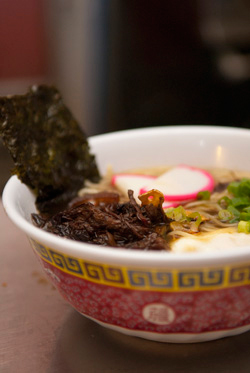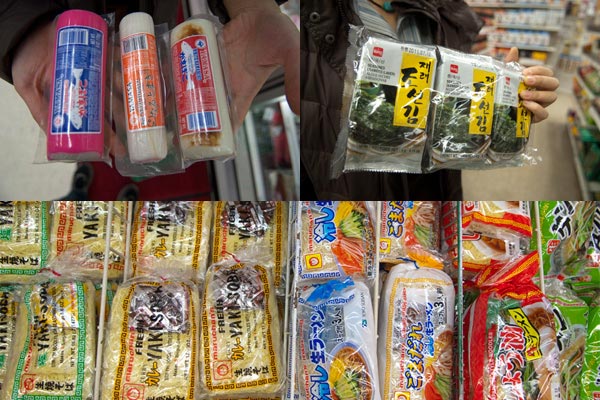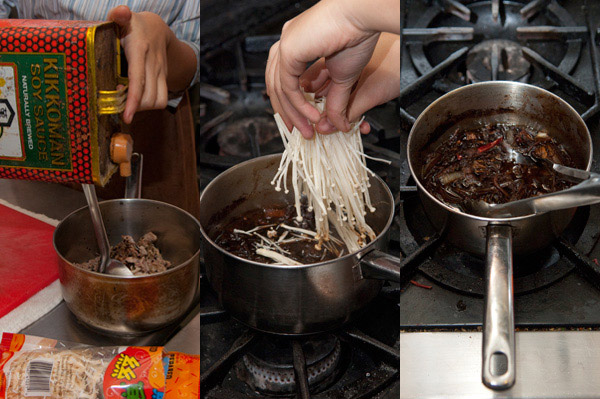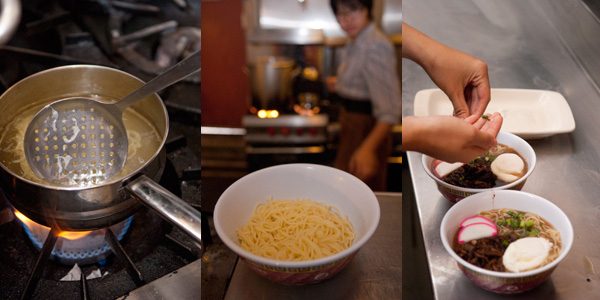
No matter who you are — yuppie or blipster, female or male, blue or red — you’ve probably slurped down a few packs of Japanese instant ramen at some point in your life. At around $1 for an eight-pack (last time I checked), the deal is undeniable. The way the dish has evolved and been diluted since the first bowl crawled out of the culinary primordial ooze speaks to its universal appeal and staying power: Sometimes all we need to keep going is a cheap, steaming bowl of wheat noodles and salty broth. However, it couldn’t hurt to branch out from the heat-and-eat variety to which most of us are accustomed.
What you get in those plastic-wrapped, freeze-dried packs is a far cry from the real thing; a mutated copy of a copy of a copy. (Fun fact: “Oriental” and “Cheddar” are not traditional varieties of ramen in Japan.) Luckily for those of us in the Western Hemisphere, quite a few “traditional” ramen-focused restaurants have popped up within the last decade, in cities with large East Asian populations such as New York, Vancouver, and Houston. Unluckily for those of us in Minnesota, only one restaurant even offers a decent version of the dish: Obento-ya Japanese Bistro, just north of the University of Minnesota’s campus, features a nice ginger-pork ramen special, but on Mondays only. Fans of foodie cinema will be disappointed to learn that St. Paul’s Tanpopo does not, in fact, serve the dish.
So what’s a ramen fanatic to do in desperate times like these? As it turns out, making your own fantastic ramen from scratch is much, much easier than “The Ramen Girl” makes it look. The recipe we came up with incorporated bits and pieces from the many, many Japanese regional variations; we just picked out what we liked, which should work well enough for most people.
The Stock
We used pork neck bones and trotters from Fischer Farms for the stock. Make sure you have a good amount of trotters in there, as they are very important for achieving the rich and velvety texture that typifies Hakata-style pork ramen. Vegetarians or those with food restrictions may certainly use vegetables or chicken to make theirs. In that case, I would recommend adding miso to really pump up the flavor. We slow-simmered our 10-gallon pot of pork, water, ginger, and onions for about 13 hours, then strained out the bones and skimmed the fat and scum off the top. Then we boiled it until the liquid reduced to 5 gallons. Though our recipe makes a lot, the stock is totally freezer-friendly. Salt it to taste and that’s it!

The Noodles
Our trip to United Noodles on Minnehaha Ave yielded a wide variety of noodle candidates. While there were a few packages of fresh noodles that were clearly labeled as ramen, they were bundled with a broth base already. Packages of yakisoba noodles were cheaper and just as good. Bigger packs of fresh noodles would have been ideal, but we couldn’t find any. If you’re in a desperate pinch (But how could you be, if you’re already simmering a stock for 13 hours? Well, I won’t pry.), you could totally use the dried variety.
The Fixings
Another thing we purchased at United Noodles was a steamed fish loaf. Pictured here (above, left) are the three varieties we found: pink kamaboko, white kamaboko, and narutomaki. It doesn’t matter which one you pick, but you only need to get one of them. If you’re wary of monosodium glutamate, you probably want to stay away from these. They’re mostly on the ramen to make it cuter, anyway.
While you’re there, don’t forget the nori! We encountered a whole section of seasoned dried seaweed in the Koreanesque section, but it doesn’t matter which one you pick. Other possible toppings include sliced green onions, fried garlic, pickled ginger, black sesame oil, mustard greens, and a poached or soft-boiled egg. We liked the richness that the runny yolk of a poached egg added to the broth.

An integral part of our recipe was the chashu, or braised pork. While it is more traditional to start with raw pork belly, we preferred to speed it up a bit by using some pulled pork that we had on hand. All we did was simmer it with some sliced onion and ginger in an equal-parts mixture of water, dark Kikkoman soy sauce, mirin, and sake. We also added a pack of enoki mushrooms to the mix for some added texture.

Putting It All Together
To construct our ramen, we boiled the fresh noodles in a separate pot of water until they loosened up, then plopped them into a bowl. Then we ladled enough pork stock to cover them, and stirred in a few spoonfuls of the chashu broth to perk up the flavor. Once the toppings were all painstakingly arranged over the noodles, we thanked the gods that we were no longer in college and dug in.


this is good Soleil, but I thought you were going to make your own noodles!!! (no pressure, hee hee)
Ha! I’ll show you guys how to make Chinese hand-pulled noodles some other time, howbout.
thanks for this. My crockpot and I will get to work on the broth! and we love the suggestions for toppings.
We have had a good bowl of ramen (with egg on top) at moto-i, but we really want to make our own.
‘Tanpopo does not…serve the dish’
Thanks for finally pointing out the elephant in the room.
Last time I was at Origami (early June) they had a decent enough ramen on the menu. Maybe it was only for lunch? Or maybe it has been removed from the menu? By “decent enough” I mean I’m grateful to find it anywhere, and this one was tasty, pretty and filling. I have always wondered why the heck Tanpopo does not offer ramen.
I’m sad that I have to go to Mitsuwa Marketplace in Chicago for really good ramen, but it’s completely worth the trip.
We have been going to Obento-ya almost every Monday for decent ramen ever since our trip to Japan last March. I would LOVE a real ramen shop to open up in Mpls!! We are going to try A25’s Ramen this week, but very diappointed that so far nothing comes close to the ticket ramen of Osaka/Tokyo!
@Kirsten
A25 is closed, and I don’t think Thom Pham’s Wondrous Azian Kitchen has ramen on their menu, unfortunately.
Origami still has it on their lunch menu (assuming their website is updated).
http://www.origamirestaurant.com/lunch.html
I share your excitement (and disappointment) about ramen.
There are better noodles at United Noodles. Directly across the aisle from the instant miso soup section is an cooler full of fresh noodles. There are a few different varieties, but the ones labeled ‘Chinese Style Noodles’ (red trim) are chewy, long, and yummy. They are sold in packs of 5. Toppings-wise, I love to sautee a handful of bean sprouts with a crushed clove of garlic (remove before serving), thinly sliced green onions, and corn. Before serving, add an egg (boil for exactly 7 min then peel and cut in half…center will be hot and semi-gelatinous). Ok…I’m really hungry now.
awsome i tried this